C Major Chord with the CAGED System: Complete Guitar Fretboard Diagrams and Tablature Guide
While I have always learned about the CAGED system, it is only recently that I have begun to try and understand that. This is partially due to where I am with learning the guitar, but also, as I work on adding chords into guitar tab creator, and the shapes are beginning to make sense to me. I thought I'd share with you what I have learned:
If you are unfamiliar, the CAGED system is a popular method for learning the fretboard of the guitar, helping guitarists understand and visualize the layout of scales and chords across the neck. This method hinges on the five basic chord shapes—C, A, G, E, and D—which serve as the building blocks for playing chords, scales, and arpeggios across the entire neck of the guitar. Each of these chord shapes can be played as open chords in their original positions near the headstock, or they can be moved along the fretboard, transformed into movable shapes or barre chords, to access a myriad of different chords and voicings. Understanding these shapes and how they relate to each other opens up a whole new world of fretboard navigation and musical expression. Here, we'll dive into detailed tablature and fretboard diagrams for each of the CAGED shapes, giving both beginners and advanced players a clear visual guide to enhance their fretboard knowledge and guitar technique. The system is named after the five basic open chord shapes: C, A, G, E, and D. It revolves around the concept that these shapes can be moved up and down the neck with the use of a capo or by playing barre chords, effectively creating a roadmap for navigating the guitar fretboard. An "aha" moment for we was understanding that the chord shapes follow the pattern C-A-G-E-D. What I learned is that, if you are starting on A, the order of the shapes down the neck would be A-G-E-D-C.
Here's how it works:
- Chord Shapes: Learn the five basic open chord shapes—C, A, G, E, and D.
- Moving Shapes: Understand how to move these shapes up the neck to play the same chord with different voicings. For example, you can play a C chord in the open position, and you can also move the A shape up the neck to form a C chord at the third fret.
- Scale Integration: Apply these chord shapes to scales. Each shape has a corresponding scale pattern that fits around it. This integration helps in soloing and improvisation.
- Root Notes: Identify the root notes in each shape. This helps in locating different chords and scales on the fretboard quickly.
- Connecting Patterns: Practice connecting these patterns to see the fretboard as a whole rather than in segments.
First, let's go through each of the shapes:
C Shape:
C Shape Tablature: e|---0--- B|---1--- G|---0--- D|---2--- A|---3--- E|-------C Shape Fretboard Diagram
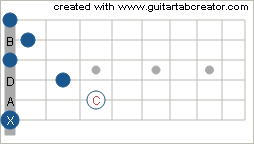
A Shape:
A Shape Tablature: e|---0--- B|---2--- G|---2--- D|---2--- A|---0--- E|-------A Shape Fretboard Diagram
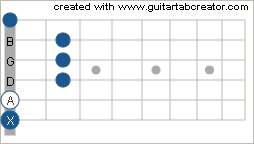
G Shape:
G Shape Tablature: e|---3--- B|---0--- G|---0--- D|---0--- A|---2--- E|---3---G Shape Fretboard Diagram
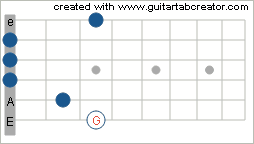
E Shape:
E Shape Tablature: e|---0--- B|---0--- G|---1--- D|---2--- A|---2--- E|---0---E Shape Fretboard Diagram
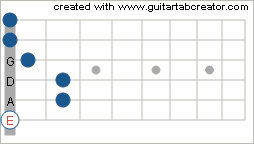
D Shape:
D Shape Tablature: e|---2--- B|---3--- G|---2--- D|---0--- A|------- E|-------D Shape Fretboard Diagram: 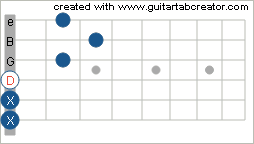
How do these apply to a specific note, like the C?
These should be fairly familiar if you have been playing for a while, they are all of the open chords most of us learn first. But once you start barring chords, then the magic of the CAGED system begins to take shape (pun intended). But how do these apply to a specific note? Essentially you can traverse the neck of the guitar using this system to find each of the subsequent chords on the fretboard. I decided to learn how to traverse down the fretboard with these using the C Major Chord as my example. We know the first Chord Shape "C", so now we need to go down the fretboard to find the C Major Chords with the Shapes of A, then G, E, and finally D. Heres a Table showing these:
C Shape:
This is the basic open C major chord.e|---0--- B|---1--- G|---0--- D|---2--- A|---3--- E|-------Open C Shape 
A Shape:
To play a C major chord using the A shape, you move the A major shape up to the third fret and play it as a barre chord:e|---3--- B|---5--- G|---5--- D|---5--- A|---3--- E|-------A Shape on 3rd Fret 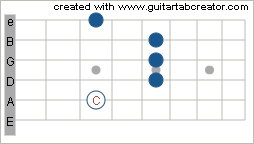
This is typically barred with the index finger on the 3rd fret.
G Shape:
The G shape moved up to form a C chord is a bit of a stretch, but it is played starting at the fifth fret:e|---8--- B|---8--- G|---9--- D|---10-- A|---10-- E|---8---G Shape on 5th Fret 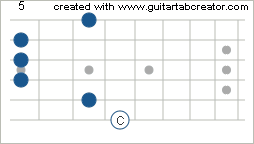
This shape is also barred, usually with the index finger on the 8th fret.
E Shape:
Moving the E major shape up to the eighth fret forms a C major chord:e|---8--- B|---8--- G|---9--- D|---10-- A|---10-- E|---8---E Shape on the 8th Fret
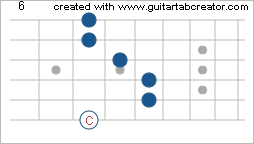
Here, you bar the 8th fret with the index finger, playing the familiar E major shape up the neck.
D Shape:
The D shape moved up to create a C chord starts on the tenth fret:e|---12--- B|---13--- G|---12--- D|---10--- A|-------- E|--------D Shape on the 10th Fret 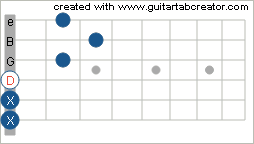
This shape is played without a barre, using the individual fingers to press the noted frets.
These diagrams show how you can play a C major chord in different positions on the neck using the CAGED system. Each shape gives a different voicing and tonal quality, allowing for creative applications in various musical contexts.
Here are all of the Shapes laid out on a fretboard (link to the CAGED C Shapes):

Here it is as an animation:

In summary, the CAGED system offers an insightful and structured approach to mastering the fretboard through the lens of the C major chord. By exploring each of the CAGED shapes—C, A, G, E, and D—you can effectively navigate the entire guitar neck, enhancing your ability to form chords, transition seamlessly between them, and expand your musical vocabulary. The fretboard diagrams and tablature featured in this guide were meticulously crafted using the intuitive tools provided by Guitar Tab Creator. These visual aids are designed to help you grasp the theoretical concepts with practical applications, making it easier for guitarists of all levels to apply these techniques in their daily practice and performances. With these resources at your disposal, you are well-equipped to delve deeper into the art of guitar playing and explore new musical possibilities.